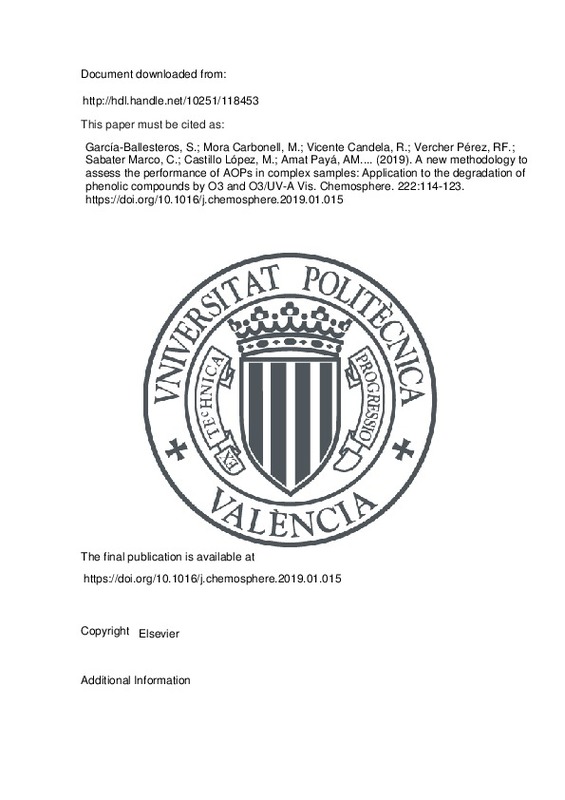García-Ballesteros, S.; Mora Carbonell, M.; Vicente Candela, R.; Vercher Pérez, RF.; Sabater Marco, C.; Castillo López, M.; Amat Payá, AM.... (2019). A new methodology to assess the performance of AOPs in complex samples: Application to the degradation of phenolic compounds by O3 and O3/UV-A Vis. Chemosphere. 222:114-123. https://doi.org/10.1016/j.chemosphere.2019.01.015
Por favor, use este identificador para citar o enlazar este ítem: http://hdl.handle.net/10251/118453
|
Título:
|
A new methodology to assess the performance of AOPs in complex samples: Application to the degradation of phenolic compounds by O3 and O3/UV-A Vis
|
|
Autor:
|
 García-Ballesteros, Sara
García-Ballesteros, Sara

 Mora Carbonell, Margarita
Mora Carbonell, Margarita

 Vicente Candela, Rafael
Vicente Candela, Rafael

 Vercher Pérez, Rosa Francisca
Vercher Pérez, Rosa Francisca
 Sabater Marco, Consuelo
Sabater Marco, Consuelo

 Castillo López, María-Ángeles
Castillo López, María-Ángeles

 Amat Payá, Ana María
Amat Payá, Ana María

 Arqués Sanz, Antonio
Arqués Sanz, Antonio
|
|
Entidad UPV:
|
Universitat Politècnica de València. Departamento de Matemática Aplicada - Departament de Matemàtica Aplicada
Universitat Politècnica de València. Departamento de Ingeniería Textil y Papelera - Departament d'Enginyeria Tèxtil i Paperera
Universitat Politècnica de València. Departamento de Biotecnología - Departament de Biotecnologia
|
|
Fecha difusión:
|
|
|
Resumen:
|
[EN] A methodology combining experimental design methodology, liquid chromatography, excitation emission matrixes (EEM) and bioassays has been applied to study the performance of O3 and O3/UVA-vis in the treatment of a ...[+]
[EN] A methodology combining experimental design methodology, liquid chromatography, excitation emission matrixes (EEM) and bioassays has been applied to study the performance of O3 and O3/UVA-vis in the treatment of a mixture of eight phenolic pollutants. An experimental design methodology based on Doehlert matrixes was employed to determine the effect of pH (between 3 and 12), ozone dosage (02¿1.0¿g/h) and initial concentration of the pollutants (1¿6¿mg/L each). The following conclusions were obtained: a) acidic pH and low O3 dosage resulted in an inefficient process, b) increasing pH and O3 amount produced an enhancement of the reaction, and c) interaction of basic pH and high amounts of ozone decreased the efficiency of the process. The combination of O3/UVA-vis was able to enhance ozonation in those experimental regions were this reagent was less efficient, namely low pH and low ozone dosages. The application of EEM-PARAFAC showed four components, corresponding to the parent pollutants and three different groups of reaction product and its evolution with time. Bioassys indicated important detoxification (from 100% to less than 30% after 1¿min of treatment with initial pollutant concentration of 6¿mg/L, pH¿=¿9 and ozone dosage of 0.8¿g/h) according to the studied methods (D. magna and P. subcapitata). Also estrogenic activity and dioxin-like behavior were significantly decreased.
[-]
|
|
Palabras clave:
|
Ozone
,
UV-Vis
,
Phenolic compounds
,
Doehlert matrix
,
Toxicity
,
Excitation-emission matrix fluorimetry
|
|
Derechos de uso:
|
Reconocimiento - No comercial - Sin obra derivada (by-nc-nd)
|
|
Fuente:
|
Chemosphere. (issn:
0045-6535
)
|
|
DOI:
|
10.1016/j.chemosphere.2019.01.015
|
|
Editorial:
|
Elsevier
|
|
Versión del editor:
|
https://doi.org/10.1016/j.chemosphere.2019.01.015
|
|
Código del Proyecto:
|
info:eu-repo/grantAgreement/EC/FP7/269128/EU/Isolation, Characterization and screening of environmental applications of Bio-Organic substances obtained from urban biomasses (EnvironBOS)/
info:eu-repo/grantAgreement/MINECO//BES-2013-066201/ES/BES-2013-066201/
info:eu-repo/grantAgreement/MINECO//CTQ2015-69832-C4-4-R/ES/TECNOLOGIAS EFICIENTES PARA LA ELIMINACION DE CONTAMINANTES DE PREOCUPACION EMERGENTE, CONTENIDOS EN DIRECTIVA 2013%2F39%2FCE O DE RIESGO SIGNIFICATIVO SEGUN DIRECTIVA 2008%2F105%2FCE/
|
|
Agradecimientos:
|
The authors thank the financial support of the European Union(PIRSES-GA-2010-269128, EnvironBOS) and Spanish Ministerio de Educación y Ciencia (CTQ2015-69832-C4-4-R). Sara García-Ballesteros thanks Spanish Ministerio de ...[+]
The authors thank the financial support of the European Union(PIRSES-GA-2010-269128, EnvironBOS) and Spanish Ministerio de Educación y Ciencia (CTQ2015-69832-C4-4-R). Sara García-Ballesteros thanks Spanish Ministerio de Economía y Competitividad for providing her fellowship (BES-2013-066201).
[-]
|
|
Tipo:
|
Artículo
|







![[Cerrado]](/themes/UPV/images/candado.png)


